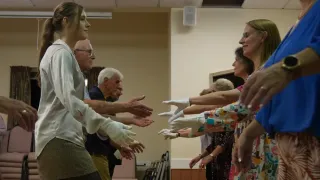September 22, 2017
Researchers May Have Found a Way To 'Kick And Kill' HIV
READ TIME: 4 MIN.
Current anti-AIDS drugs are highly effective at controlling viral loads, making the human immunodeficiency virus undetectable in HIV-positive individuals and allowing them to live longer, healthier lives. They also greatly reduce the chance of transmission from person to person.
But the medications, known as antiretroviral therapy, do not rid the body of the virus, which has the ability to hide out and lay dormant in CD4+ T cells, or reservoirs, thus eluding medications. When a person goes off treatment, the virus emerges and replicates in the body, weakening the immune system and raising the likelihood of opportunistic infections or cancers that can sicken or kill the patient.
Researchers have been looking for ways to eliminate these viral reservoirs. One potential approach is "kick and kill," in which an agent "wakes up" the dormant virus, causing it to begin replicating so viral proteins on the infected cell can then be targeted to kill it. Destruction of all these reservoir cells could reduce or eradicate HIV entirely.
Now, a team of researchers from the UCLA Center for AIDS Research, Stanford University and the National Institutes of Health may have developed a synthetic molecule that both "kicks" and "kills." The research was published Sept. 21 in the peer-reviewed journal PLOS Pathogens.
"The latent HIV reservoir is very stable and can re-activate virus replication if a patient stops taking antiretroviral drugs for any reason," said lead author Matthew Marsden, assistant professor of medicine, division of hematology-oncology at the David Geffen School of Medicine at UCLA. "Our studies suggest that there may be means of activating latent virus in the body while the patient is on antiretroviral drugs to prevent the virus from spreading and that this may result in the elimination of at least some of the latent reservoir. With further development, this approach may lower the viral reservoir such that a patient might be able to stop their anti-viral therapy."
For this study, the researchers transplanted human immune tissues into mice that had no immune system of their own. Because mice by nature cannot be infected with HIV, this process allowed infection of the human cells by the virus. Previous research had shown that latent HIV reservoirs could be detected in these "humanized" mice. In the current study, the researchers placed HIV-infected mice on anti-retroviral drugs to halt virus replication, and then introduced a synthetic compound called SUW133 developed by colleagues at Stanford University, which can activate dormant HIV in tissue culture studies.
They found that up to 25 percent of the cells that began expressing HIV died within 24 hours of activation. This shows that this compound activated latent HIV in the human cells in the mice, and resulted in the death of some of the previously latently infected cells. The findings suggest that this compound or future compounds with similar activities may be effective in lowering or eliminating latent HIV in the body.
"These findings are significant because several attempts have been tried by many groups to activate latent virus so it can be detected and destroyed, but they've had limited success," said senior author Jerome Zack, professor and chair of the UCLA Department of Microbiology, Immunology and Molecular Genetics at the Geffen School and director of the UCLA Center for AIDS Research. "Most studies showed weak activation of virus, or severe toxicities of the approach, with little effect on the reservoir."
The current study uses a synthetic molecule based on bryostatin 1, a natural compound extracted from a marine animal known as Bugula neritina. The study found that the new compound is less toxic than the natural compound, that it can activate virus protein expression, and that this results in the removal of some of the latently infected cells from the body.
The researchers stress that this molecule was tested on humanized mice, and results in animal models do not necessarily translate to humans. More work is needed to lessen toxicity and further tests in larger animal models are needed before clinical testing in humans can begin.
Xiaomeng Wu and Christina M. Ramirez of UCLA; Brian A. Loy, Adam J. Schrier, Akira Shimizu, Steven M. Ryckbosch, Katherine E. Near, and Paul A. Wender of Stanford University; and Danielle Murray and Tae-Wook Chun of the National Institute of Health's National Institute of Allergy and Infectious Diseases are the study's authors.
The National Institutes of Health AI70010 and U19AI096113, project 3.4; CA31841; CA31845; AI124743l; and AI124763), a Bill and Melinda Gates Foundation Explorations grant (OPP1032668), the James B. Pendleton Charitable Trust, and the UCLA Center for AIDS Research (AI28697) funded this research.







